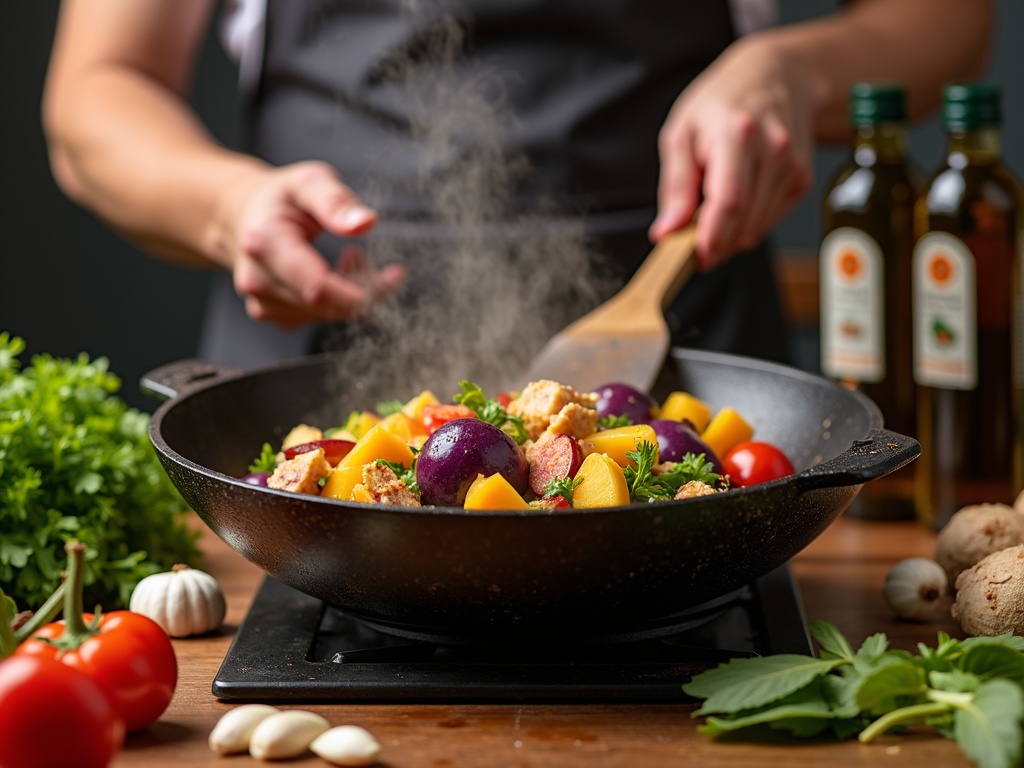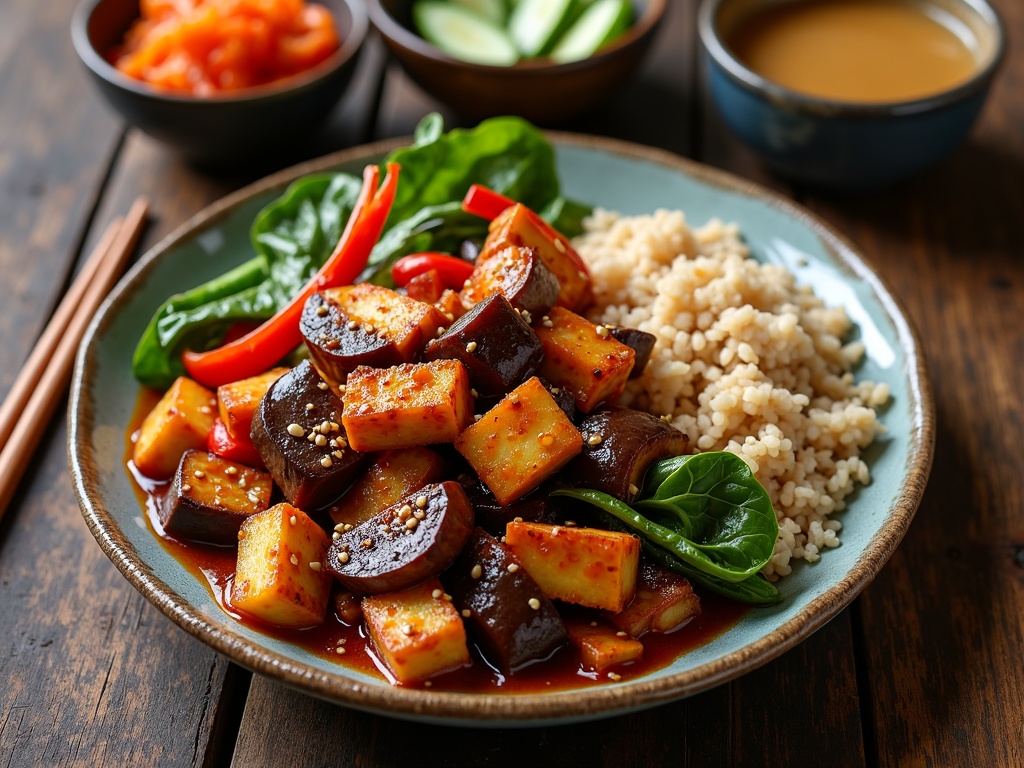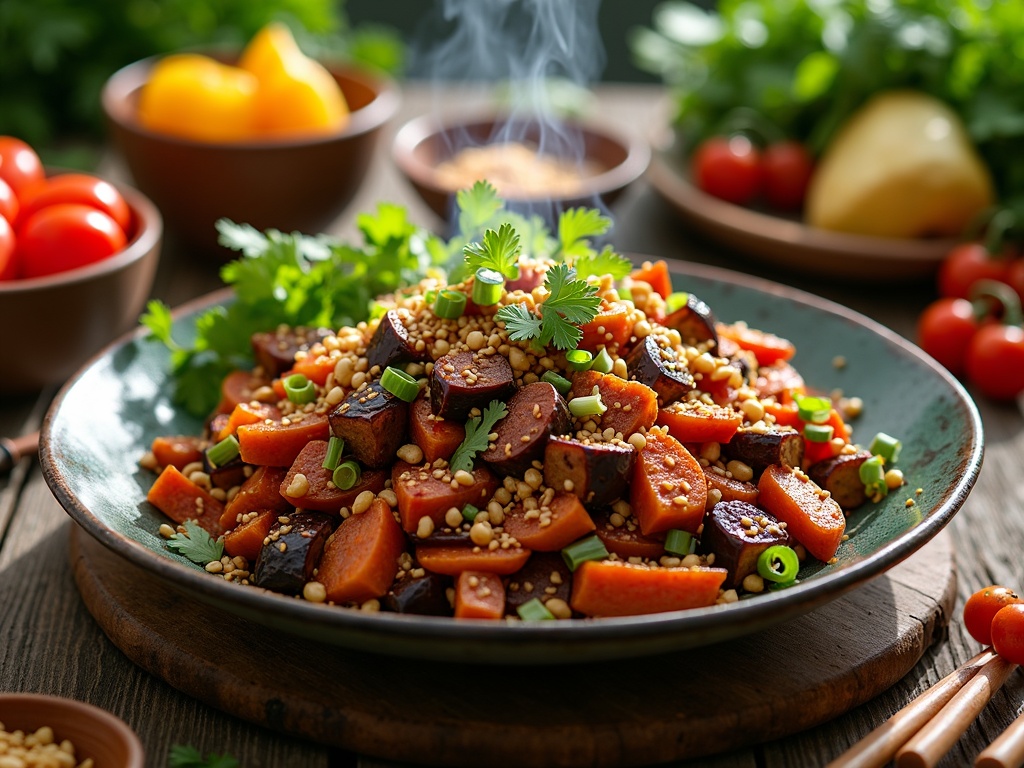This Korean-inspired eggplant gochujang stir-fry combines the deep umami flavors of fermented chili paste with the subtle, meaty texture of eggplant to create a harmonious dish. The porous nature of eggplant absorbs the spicy-sweet flavors of the gochujang sauce, resulting in a nutritious meal that delivers impressive flavor without excessive calories.
Find In This Article
Key Takeaways
- The combination of eggplant and gochujang creates complementary flavor profiles with balanced nutrition, offering protein, fiber, and moderate calories.
- Stir-frying preserves up to 80% of vegetable antioxidants due to its high-heat, short-duration cooking technique.
- The perfect sauce combines gochujang paste, soy sauce, rice vinegar, sweetener, and aromatics like garlic and sesame oil.
- Adding protein such as crispy tofu, tempeh, or chickpeas transforms this dish from a side into a complete, satisfying meal.
- Eggplant contains nasunin, a powerful antioxidant that protects brain cells, while fermented gochujang provides beneficial probiotics for gut health.
Why Eggplant and Gochujang are a Perfect Match
I’ve discovered that few ingredient pairings create such harmony as eggplant and gochujang. The deep, savory umami from gochujang beautifully complements eggplant’s subtle, slightly bitter taste profile. This combination transforms a simple stir-fry into something truly special.
A Flavor and Nutrition Powerhouse
Gochujang, the Korean fermented chili paste, brings complex flavors to any dish it touches. Made from red chili peppers, glutinous rice, fermented soybeans, and salt, this paste packs a punch of heat balanced with subtle sweetness. At just 60 calories per tablespoon, it delivers tremendous flavor without weighing down your meal. The fermentation process creates that distinctive umami quality that makes eggplant shine.
Eggplant serves as the perfect canvas for gochujang’s bold character. With only 25 calories per 100g, eggplant is surprisingly low in calories while offering a satisfying, meaty texture. It also provides about 3g of fiber per 100g, supporting digestive health while absorbing all those amazing flavors from the gochujang.
The global market has caught on to gochujang’s appeal, with projections showing growth to $650 million by 2025. This surge in popularity isn’t surprising given how versatile this ingredient is, especially when paired with vegetables like eggplant.
When preparing this dynamic duo, I find that the eggplant’s porous nature allows it to soak up the gochujang sauce perfectly. This creates layers of flavor that simple stir-frying techniques can bring out beautifully. For even more texture variation, consider adding crispy tofu pieces to complement the soft eggplant.
The combination works particularly well in quick-cooking methods, making it perfect for weeknight meals. The key benefits of this pairing include:
- Complementary flavor profiles that enhance each other
- Balanced nutrition with protein, fiber, and moderate calories
- Quick cooking time that preserves texture and nutrients
- Versatility in seasoning and accompanying ingredients
For an impressive meal that showcases this pairing, try serving your eggplant gochujang stir-fry alongside a simple vegetable curry for a fusion dinner that will impress your guests.
Master the Art of Stir-Frying for Maximum Nutrition
Stir-frying isn’t just about creating quick, delicious meals—it’s a cooking method that preserves up to 80% of vegetable antioxidants due to its high-heat, short-duration technique. I’ve found that mastering this method transforms ordinary eggplant into exceptional dishes while keeping nutritional benefits intact.
Selecting and Preparing Your Equipment
The foundation of successful stir-frying starts with choosing the right wok. Cast-iron and carbon steel woks stand out as top choices due to their heat retention capabilities and durability. Before first use, I always season my wok by heating it until smoking, then rubbing it with a thin layer of oil. This creates a natural non-stick surface that improves with each use.
Equally important is selecting the right oil. High smoke point oils are essential since stir-frying requires temperatures around 400°F. Canola, peanut, or avocado oils work perfectly as they won’t break down or release harmful compounds at high temperatures. I typically use about 1-2 tablespoons per stir-fry session—just enough to coat ingredients without making the dish greasy.
Perfecting Your Technique
Proper vegetable preparation makes all the difference in a successful vegetable stir-fry dish. For eggplant gochujang stir-fry, I cut eggplant into uniform 1-inch cubes to ensure even cooking. Pre-salting the eggplant for 15-20 minutes draws out excess moisture and bitterness, resulting in better texture and flavor absorption.
The actual cooking process requires attention to detail:
- Heat your wok until it’s smoking slightly before adding oil
- Add aromatics like garlic, ginger, and onions first, cooking for just 30 seconds
- Introduce harder vegetables before softer ones (eggplant goes in later in the process)
- Keep ingredients moving constantly with a spatula or wok turner
- Cook in small batches to maintain high heat (overcrowding creates steam instead of sear)
- Add gochujang sauce near the end to prevent burning
The key to preserving nutrients lies in the quick cooking time. Most vegetables, including eggplant, should be cooked until just tender-crisp—typically 3-5 minutes total. This rapid cooking locks in vitamins that would otherwise be lost during longer cooking methods.
For protein additions like crispy tofu, I pre-cook separately before combining with vegetables. This ensures each component receives its ideal cooking time without compromising texture or nutrition.
By mastering these stir-frying techniques, you’ll create an eggplant gochujang dish that’s not just bursting with flavor but also retains maximum nutritional benefits—proving that delicious and healthy aren’t mutually exclusive.

Create the Perfect Stir-Fry Sauce
The foundation of an unforgettable Eggplant Gochujang Stir-Fry lies in its sauce—a harmonious blend of sweet, spicy, tangy, and savory elements. I’ve found that creating a balanced sauce makes all the difference between an ordinary dish and one that leaves you craving more.
The Essential Sauce Components
The heart of this stir-fry sauce combines three key ingredients that work together beautifully. Gochujang, a Korean fermented chili paste, provides the perfect balance of heat and sweetness with its complex flavor profile. When mixed with the umami-rich soy sauce and the bright acidity of rice vinegar, it creates a trifecta of flavor that coats your eggplant perfectly.
For the best results, I mix:
- 2 tablespoons gochujang paste
- 1 tablespoon soy sauce (low-sodium works well)
- 1 tablespoon rice vinegar
- 1 teaspoon honey or maple syrup for added sweetness
- 1-2 tablespoons water to adjust consistency
Fresh garlic is non-negotiable in this sauce. When crushed, garlic releases allicin, a compound with impressive health benefits. Allicin has been shown to have antimicrobial and antioxidant properties that support immune function. Beyond its health perks, garlic adds an aromatic depth that elevates the entire dish, especially when it’s allowed to bloom in hot oil before other ingredients are added.
Finishing the sauce with sesame oil adds a nutty complexity that ties everything together. At approximately 40 calories per teaspoon, sesame oil is calorie-dense but packed with healthy unsaturated fats. These fats help your body absorb the fat-soluble nutrients from the vegetables in your vegetable stir-fry. The distinctive flavor means a little goes a long way—I typically use just 1-2 teaspoons at the end of cooking to preserve its delicate flavor compounds.
Balancing and Adjusting Your Sauce
Creating the perfect stir-fry sauce is like conducting a flavor orchestra—each element needs to play its part without overwhelming the others. I always taste and adjust my sauce before adding it to the eggplant.
If your sauce tastes too spicy, consider adding:
- A touch more sweetener (honey or maple syrup)
- A splash of water to dilute the heat
- A bit more soy sauce to amplify umami and balance spice
For a sauce that lacks punch, try:
- Adding more gochujang for heat and depth
- Incorporating minced ginger for brightness
- Including a splash more rice vinegar for tang
The texture of your sauce matters as much as its flavor. For a thicker sauce that clings to your crispy tofu or eggplant pieces, consider adding a cornstarch slurry (1 teaspoon cornstarch mixed with 1 tablespoon cold water). For a thinner, more coating sauce, add water or broth in small increments.
Remember that your sauce will reduce and intensify as it cooks with the eggplant, so it’s better to start slightly milder than your desired end result. The eggplant itself will release moisture and absorb flavors, creating a dynamic exchange that transforms both the vegetable and the sauce during cooking.
With these guidelines, you’ll create a stir-fry sauce that transforms simple eggplant into a memorable main course bursting with Korean-inspired flavors.
Build Your Complete Meal
I’ve found that the key to transforming this Eggplant Gochujang Stir-Fry from a simple side dish into a satisfying main course is balancing it with complementary ingredients. Adding protein isn’t just delicious—it’s essential for creating a nutritionally complete meal.
Protein and Portion Planning
For a protein boost, crispy tofu is my go-to addition, providing approximately 8g of protein per 100g serving. The firm texture contrasts beautifully with the tender eggplant while soaking up the spicy gochujang sauce. Other excellent protein options include:
- Tempeh cubes (marinated for 30 minutes before cooking)
- Edamame beans (added during the final 2 minutes of cooking)
- Seitan strips (pre-seared for extra flavor)
- Chickpeas (crisped in the pan before adding eggplant)
I recommend a serving size of 1 cup per portion for the completed stir-fry. This creates a filling meal without overwhelming your plate or your stomach.
The stir-fry pairs perfectly with steamed short-grain brown rice, which adds a nutty flavor and chewy texture that complements the soft eggplant. For something lighter, try cauliflower rice or quinoa. When I’m craving noodles, soba or rice noodles make an excellent base.
To boost the nutritional profile, I mix in additional vegetables like bell peppers, snow peas, or bok choy. These additions create a colorful meal packed with various vitamins and minerals. For an interesting twist, try mixing in some curry-inspired vegetables like cauliflower or spinach—the gochujang sauce works surprisingly well with these ingredients.
For a complete dining experience, serve your stir-fry with simple sides like kimchi, quick-pickled cucumbers, or a small bowl of miso soup. These accompaniments provide contrasting flavors that highlight the spicy-sweet profile of the gochujang sauce while adding probiotics and additional nutrients to your meal.

Make It Your Own with Toppings and Variations
The beauty of Eggplant Gochujang Stir-Fry lies in its versatility. I’ve found that personalizing this dish with different toppings and preparation methods can transform it from a simple meal to something truly spectacular. Adding your own creative touch not only enhances flavors but also allows you to adapt the dish to various occasions and dietary preferences.
Elevate with Garnishes and Fresh Herbs
Adding the right garnishes can take your Eggplant Gochujang Stir-Fry to new heights. Here are some of my favorite finishing touches that add texture, flavor, and visual appeal:
- Toasted sesame seeds sprinkled on top add a nutty crunch and complement the gochujang’s depth
- Chopped peanuts create a satisfying texture contrast with the tender eggplant
- A drizzle of sesame oil just before serving intensifies the aromatic profile
- Crispy fried shallots offer a savory crunch that pairs beautifully with the spicy sauce
- Crumbled tofu can add protein and a pleasant textural element
Fresh herbs aren’t just garnish – they’re flavor game-changers that cut through the richness of the gochujang. I particularly enjoy adding cilantro for its bright, citrusy notes that balance the spice. Green onions provide a mild oniony bite that works perfectly with the Korean flavors. For an unexpected twist, try Thai basil leaves or mint, which add refreshing aromatic qualities.
This dish adapts beautifully to different serving temperatures. Served hot, it delivers immediate comfort with the gochujang’s warming spice front and center. I sometimes prepare it ahead and serve it at room temperature as part of a buffet spread – the flavors actually intensify as they meld. For summer gatherings, I’ve even chilled it slightly and served it as a cold vegetable dish alongside rice, creating a satisfying main course option.
The transformation from side dish to main course happens easily with a few smart additions. For a protein boost, I add pan-seared tofu cubes or crispy tofu directly into the stir-fry. Mushrooms – particularly shiitake or king oyster varieties – add meaty texture and umami depth. Adding more vegetables like bell peppers, zucchini, or carrots creates a complete one-pan meal.
As a side dish, I keep it simpler and more focused on the eggplant-gochujang combination. This pairs wonderfully with grilled meats, steamed fish, or alongside other Korean-inspired dishes. The stir-fry also makes an excellent topping for rice bowls or can be wrapped in lettuce leaves for a light lunch option.
For those who enjoy fusion cooking, I’ve successfully incorporated this stir-fry into unexpected applications. The spicy eggplant works beautifully as a filling for tortang talong (Filipino eggplant omelet) or as a topping for flatbreads with a dollop of yogurt. I’ve even used leftover stir-fry as a stuffing for dumplings, creating a cross-cultural appetizer that never fails to impress guests.
The dish’s flavor profile can be adjusted depending on your preference. For a more Chinese-inspired version, I incorporate a touch of five-spice powder and serve it alongside a vegetable curry. For Indian fusion, adding garam masala creates an interesting dimension that works surprisingly well with the gochujang base.
Remember that the key to successful variations lies in understanding the core flavors – the earthy eggplant, spicy-sweet gochujang, and aromatic base – then building your additions to complement rather than compete with these elements.

Health Benefits and Nutrition Facts
Eggplant Gochujang Stir-Fry isn’t just a flavorful dish—it’s packed with nutrients that support overall health. I’ve found that incorporating this stir-fry into my meal rotation provides numerous benefits while satisfying my taste buds.
Powerful Nutritional Components
Eggplants contain a unique antioxidant called nasunin, primarily found in their purple skin. This powerful compound helps protect brain cell membranes from damage caused by free radicals. Research suggests that nasunin may help delay the development of cognitive disorders by maintaining proper blood flow to the brain.
The gochujang paste that gives this dish its characteristic heat brings more than just flavor. This fermented Korean condiment contains beneficial probiotics that support gut health. These friendly bacteria aid digestion and boost immune function—making this dish as good for your insides as it is delicious.
Fiber content is another major benefit of this stir-fry. Eggplant is particularly high in dietary fiber, which helps:
- Promote regular bowel movements
- Control blood sugar levels
- Create a feeling of fullness, potentially aiding weight management
- Support a healthy gut microbiome
The stir-frying method used in this recipe also helps preserve the antioxidant content of the vegetables. Unlike boiling, which can cause water-soluble nutrients to leach out, quick stir-frying retains most of the beneficial compounds while making them more bioavailable.
I’ve noticed improved digestion since adding more plant-based Asian dishes like this to my diet. The combination of fiber-rich eggplant and probiotic-containing gochujang creates a synergistic effect that supports digestive health in multiple ways.
For those looking to add more plant protein to their diet, this dish pairs beautifully with protein-rich side dishes like tofu or legumes. This stir-fry also works as an excellent side dish alongside other vegetable-forward mains like Filipino eggplant recipes, creating a nutritionally complete meal.
The flavor-packed nature of this dish means you can enjoy these health benefits without sacrificing taste or adding excess salt. The complex flavors of gochujang provide satisfaction while supporting your body’s needs—proving that healthy eating can be both nourishing and delicious.
Sources:
“Nutrition and Health Benefits of Eggplant” – Journal of Nutritional Sciences
“Gochujang: The Rising Star of Flavor” – Food & Beverage International
“The Science of Stir-Frying: Nutritional Retention” – Journal of Culinary Science & Technology
“Health Benefits of Garlic” – Healthline

